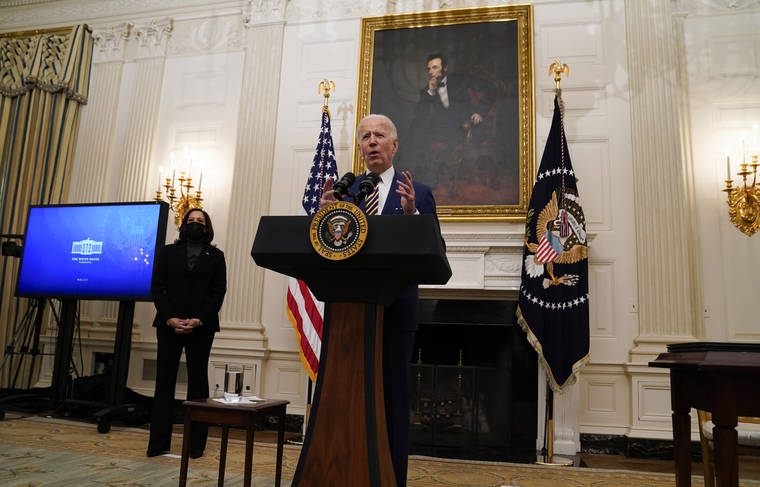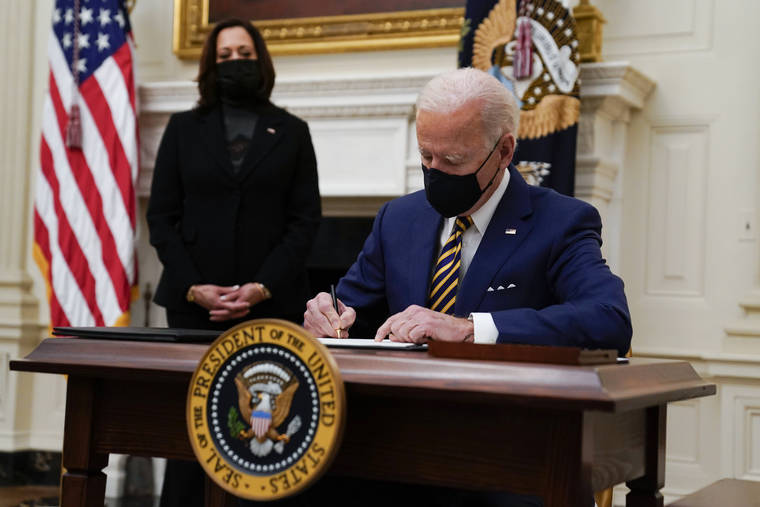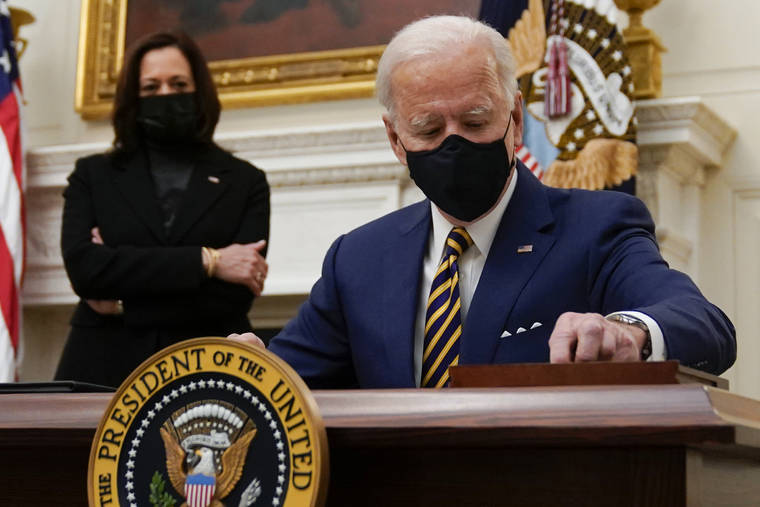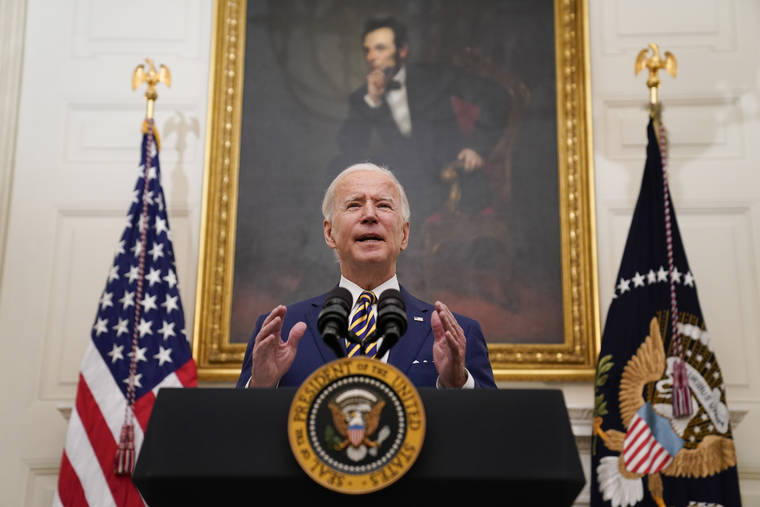Biden: Coronavirus aid an ‘economic imperative’

President Joe Biden delivers remarks on the economy in the State Dining Room of the White House, Friday, Jan. 22, 2021, in Washington. Vice President Kamala Harris listens at left. (AP Photo/Evan Vucci)

President Joe Biden signs executive orders on the economy in the State Dining Room of the White House, Friday. Vice President Kamala Harris looks on at left. (AP Photo/Evan Vucci)

President Joe Biden signs executive orders on the economy in the State Dining Room of the White House, Friday, Jan. 22, 2021, in Washington. Vice President Kamala Harris looks on at left. (AP Photo/Evan Vucci)

President Joe Biden delivers remarks on the economy in the State Dining Room of the White House, Friday. (AP Photo/Evan Vucci)
WASHINGTON — President Joe Biden signed two executive orders Friday to provide help to struggling families and raise wages for certain workers, turning once again to the power of the executive branch to advance his economic goals as the legislative chances for his broader stimulus package remain uncertain.
WASHINGTON — President Joe Biden signed two executive orders Friday to provide help to struggling families and raise wages for certain workers, turning once again to the power of the executive branch to advance his economic goals as the legislative chances for his broader stimulus package remain uncertain.
“The crisis is only deepening,” Biden said during remarks at the White House, calling the need to help those out of work and unable to afford enough food “an economic imperative.”
“We have the tools to help people,” he said. “So let’s use the tools. All of them. Now.”
Biden’s executive orders are intended to increase the amount of money poor families get for food each month and provide additional meal money for needy students whose schools have been closed as a result of the coronavirus pandemic. The president will also direct the Treasury Department to find ways to deliver stimulus checks to at least 8 million Americans who are eligible for money but have not yet received funds.
A second executive order will lay the groundwork for the federal government to require a $15 per hour minimum wage for its employees and contract workers, while making it easier for federal workers to bargain collectively for better pay and benefits.
The moves are the latest attempt in a week full of executive actions by Biden to quickly address the economic fallout from the pandemic. On Wednesday, his first day in office, Biden issued orders extending federal moratoriums on some foreclosures and evictions through the end of March and a pause on student loan payments through the end of September.
Most presidents occasionally turn to executive actions, but Biden’s decision to sign 29 orders and other directives in three days shows how he is trying to undo President Donald Trump’s agenda and begin to carve his own.
The orders Biden signed Friday were aimed at what White House officials called a “growing hunger crisis facing 29 million adults” and up to 12 million children, which has driven families across the country to line up outside food banks for assistance.
But the president’s executive powers are somewhat limited, and the steps that Biden is taking are relatively small and targeted given the scope of the economic pain coursing through the country. Millions of Americans remain out of work and another 900,000 filed for unemployment insurance Thursday.
Biden, nodding to that reality, once again appealed to Congress to pass the $1.9 trillion package he outlined this month, saying the economy would be worse off if the U.S. did not spend money now to prevent further pain.
“There is a growing economic consensus that we must act decisively and boldly,” he said. “This cannot be what we are as a country. We cannot, will not let people go hungry. We cannot watch people lose their jobs, and we have to act.”
Brian Deese, director of the National Economic Council, said Friday that the orders would provide some immediate relief for families but that they are not a replacement for the type of sweeping stimulus program that Biden had outlined.
“These actions are not a substitute for comprehensive legislative relief, but they will provide a critical lifeline to millions of families,” Deese said. “The American people are hurting, and they can’t afford to wait.”
But the president’s swift use of executive action was already drawing rebukes from Republicans. Sen. Marco Rubio of Florida panned Biden’s early moves, saying on Twitter that “a radical leftist agenda in a divided country will not help unify our country, it will only confirm 75 million Americans biggest fears about the new administration.”
Such brewing discontent shows legislative action will not come easily. Democrats hold a slim majority in Congress and Republicans are already showing signs of resistance to another spending package. That resistance is expected to only increase given that Speaker Nancy Pelosi said Friday that she would send articles of impeachment to the Senate next week. That could delay any legislative move on stimulus and further anger Republicans who do not believe the Senate should proceed with an impeachment trial against former President Donald Trump.
The White House is wrestling with whether to spend time trying to find a bipartisan agreement, as Biden has said he would like, or to use a procedural maneuver to push at least part of his proposal through the Senate with a simple majority, avoiding the need for any Republican support.
The orders are part of Biden’s attempt to override dozens of actions taken by Trump on issues like the Keystone XL pipeline and immigration. The actions Friday signal a break from the Trump administration’s attempts to limit the scope of many federal benefits that officials said created a disincentive for Americans to work.
Biden’s latest orders would increase the weekly value of Supplemental Nutrition Assistance Program benefits, commonly known as food stamps, for about 12 million families who depend on the program the most, according to White House estimates. The president has pledged to combat food insecurity, which has soared during the pandemic, and the assistance would increase weekly benefits by 15% to 20% for a family of four, Deese said.
Congress approved enhanced benefits as part of its economic aid efforts last year, but the Trump administration did not expand benefits for households receiving the maximum benefit under the program.
The order will also increase the value of an emergency benefit, which was included in previous economic rescue legislation, to provide money for families to replace the free meals students would have been receiving at school before the pandemic. That expansion would amount to an extra $100 every two months for a family of three.
Biden will also seek to allow workers to draw unemployment benefits if they quit jobs they fear are unsafe amid the pandemic, by asserting “that workers have a federally guaranteed right to refuse employment that will jeopardize their health, and if they do so, they will still qualify for unemployment insurance,” White House officials said in a fact sheet detailing the orders.
Some Republicans fought an expansion of unemployment benefits last year, saying workers would quit jobs or avoid looking for work in order to draw government benefits. Academic research has not supported that fear, and employers have once again begun shedding jobs as the virus persists, presenting a hurdle for those who want to find employment.
Biden will also direct the Treasury Department to find new ways to get stimulus checks, including $600 checks passed in December and $1,200 checks passed in March, to as many as 8 million eligible people who have not yet received them.
The Trump administration distributed the payments through the IRS, and some individuals may not have gotten checks if they did not earn enough money to file federal income taxes.
Deese said the Treasury Department would work to create a new online portal that would allow people who have not received their payments to confirm if they are eligible and the Biden administration would also try to engage in outreach to ensure people know the money is waiting for them.
Biden’s second order seeks to undo some of Trump’s actions related to the federal workforce, including one that gave presidents more leeway to hire and fire workers and others that limited some bargaining rights for employees. The president will also direct federal agencies to determine which of their workers earn less than $15 an hour, and to develop “recommendations to promote a $15 per hour minimum wage for them,” the fact sheet said.
© 2021 The New York Times Company


